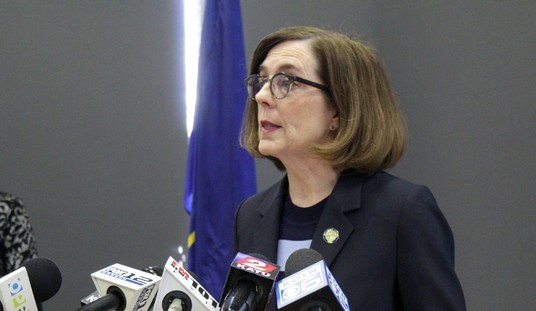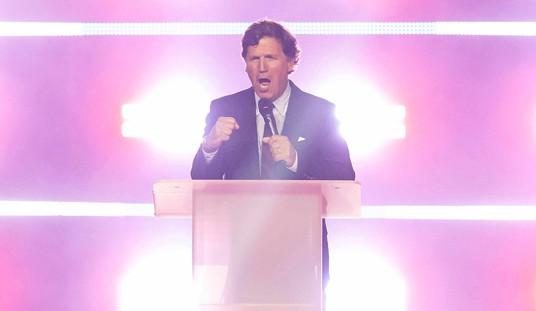What caused North Korea’s striking about-face on talks with the US over the last few days? Was Kim Jong-un never serious about it in the first place, or did elements in his regime push back? Diplomats are puzzling over this and the prospects for the first US-North Korea summit ever, but it might not be that Kim called Donald Trump’s bluff to get some personal respect from the world’s biggest superpower. It might instead be that Trump called Kim’s bluff and demanded a firm process for denuclearization — and that it start immediately:
In past months, Kim, who reportedly said he “understands” why the drills were going on, had gone forward with peace talks without asking for them to be toned down.
North Korea complained specifically about B-52 nuclear-capable bombers taking part in the military drills. But a Pentagon official told Business Insider that the bombers were never set to participate in the drills.
Additionally, North Korea invited journalists to observe the closing of its nuclear testing site after the drills had already begun.
But there is a possible motivation for North Korea’s public about-face: The US reportedly demanded swift action on denuclearization, and North Korea may be bluffing.
Business Insider points to a little-noticed report from UPI last week, based on South Korean news reports, that laid out the White House plan to pursue denuclearization. Mike Pompeo had told Kim directly that the US wanted five nuclear weapons sent to France to be dismantled in exchange for normalization of relations:
The United States asked North Korea to remove five nuclear weapons, that would be then flown to France for destruction, according to a South Korean press report.
The Segye Ilbo reported Friday the U.S request from visiting Secretary of State Mike Pompeo was part of a process to verify Kim Jong Un’s intent. …
“It is my knowledge this position was directly conveyed to Kim by Secretary of State Pompeo,” the diplomat said, adding the United States wants to shorten the time “as much as physically possible” to inspect and verify the removal of weapons.
If that’s the case, then it puts an entirely different light on what’s transpired over the last few days. It explains why the US has chosen not to react to the angry messages from Pyongyang over the last three days and instead chosen, in Trump’s words yesterday, to “wait and see.” Far from being pushed off of denuclearization, Trump and Pompeo set up a test to see whether Kim was serious or just yanking chains.
The question then becomes just whose chain in Pyongyang got yanked. Does Kim have a problem within the palace if he tries to give up the nukes in exchange for heavy investment from the West? New Yorker’s Evan Osnos heard from Victor Cha, George W. Bush’s point man on Pyongyang, who thinks this might be nothing but a pause to deal with internal politics and make Kim look stronger than he actually might be:
“I wouldn’t be completely panicked just yet.” He added, “There are hard-liners inside the North Korean government that are probably not as excited about this dramatic turn of events, and probably are dragging their feet a little bit.” As the complexity of the situation sank in, the White House, on Wednesday, took a new tack, downplaying the celebration of its progress and adopting a posture of measured optimism. “The President is ready if the meeting takes place,” Sarah Huckabee Sanders, the White House press secretary, said on Fox News. “And if it doesn’t, we will continue the maximum pressure campaign that has been ongoing.”
It was, almost certainly, not the final stutter step in lead-up to a North Korean summit. “I do feel like we are potentially on the brink of something quite historic,” Cha told me. “But the thing about being on the brink of something quite historic is that, on the one hand, it could lead to something fantastic. On the other hand, it could collapse spectacularly.”
Did the White House get surprised by the complexity of the situation, or just set up a test to expose it? That question may get left for historians to determine, but the sequence of events — and especially Pompeo’s reported message to Kim — certainly makes the latter a credible option. The “posture of measured optimism” might just be intended to allow Kim enough rope to either tie the hands of any internal hard-liners or to hang himself. In the meantime, the economic and military positions haven’t changed a whit, and pointedly won’t until Kim agrees on a verifiable path to denuclearization. Nothing at all has been lost so far, and some good insight might well have been gained. At the very least, it put our CIA director in the same room as Kim Jong-un and his advisers, which has a value all its own.
Update: And if it was a test, it’s based on past history. Glenn Kessler wrote about it ten years ago, and reminded everyone yesterday of the precedent:
The unraveling of the landmark deal to end North Korea’s nuclear weapons programs began just weeks after its high point — the televised destruction of the cooling tower at the Yongbyon nuclear reactor in late June — when U.S. negotiators presented Pyongyang with a sweeping plan for verifying its claims about its nuclear programs.
Under the proposal, heavily influenced by the State Department’s arms control experts, the U.S. requested “full access to all materials” at sites that might have had a nuclear purpose in the past. It sought “full access to any site, facility or location” deemed relevant to the nuclear program, including military facilities, according to the four-page document, a copy of which was obtained by The Washington Post. Investigators would be able to take photographs and make videos, remain on site as long as necessary, make repeated visits and collect and remove samples.
The United States pressed ahead with the proposal despite warnings from China, Russia and other countries that it was asking too much of the xenophobic North Koreans, officials said. North Korea immediately balked and the once-promising talks were at an impasse.
It’s worth noting that the South Korean news sources report that the inspection in this deal offered by Pompeo would have been conducted by the IAEA, not the US directly:
If North Korea agrees to denuclearize following the Trump-Kim summit, and Pyongyang accedes to the Treaty on the Non-Proliferation of Nuclear Weapons, or lands a similar deal bilaterally with the United States, the United Nations’ International Atomic Energy Agency will be the first to investigate the country, South Korean newspaper Munhwa Ilbo reported Friday.
North Korea’s intercontinental ballistic missiles would be subject to inspections.
That had to be a conscious but subtle concession to North Korea’s xenophobia based on the previous negotiation. It would be yet another test to see whether Pyongyang is serious about denuclearization or just throwing out smoke screens — and to make that determination well before sitting down at a summit.








Join the conversation as a VIP Member